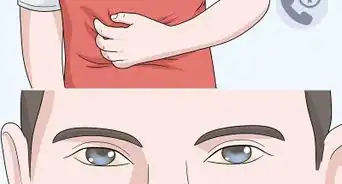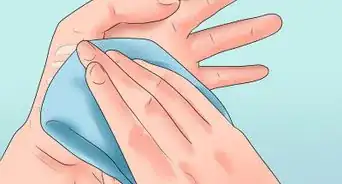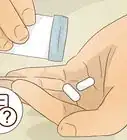This article was medically reviewed by Dale K. Mueller, MD. Dr. Mueller is a Cardiothoracic Surgeon with the Cardiothoracic & Vascular Surgical Associates group in Jacksonville, Florida. Dr. Mueller has over 25 years of experience as a surgeon and he completed his fellowship at Rush-Presbyterian-St. Luke's Medical Center in 1999. Dr. Mueller is a member of the Society of Thoracic Surgeons, Cook County Alumni Association, and Rush Surgical Society. He is board certified by the American Board of Surgeons.
There are 10 references cited in this article, which can be found at the bottom of the page.
wikiHow marks an article as reader-approved once it receives enough positive feedback. In this case, 86% of readers who voted found the article helpful, earning it our reader-approved status.
This article has been viewed 146,533 times.
Researchers agree that Jackson-Pratt (JP) drains may help you recover from surgery faster and might help prevent complications. However, you must keep your drain clean.[1] JP drains work by draining excess fluid away from your surgery site. Experts say that the fluid may be red or yellow, and sometimes you might notice red, stringy material in your drain, which is totally normal.[2] Fortunately, it's fairly easy to care for your JP drain, but talk to your doctor if you have any questions.
Steps
Learning About Jackson-Pratt Drains
-
1Recognize the importance of what Jackson-Pratt (JP) drains do. Following your surgery, you may have drainage from the wound that needs to be removed to prevent fluid, hematoma, and/or abscesses from forming. Being able to monitor the drainage also lets you watch for developing complications after your surgery. JP drains work by gentle suction which pulls out the drainage from the wound. This is done by a closed bulb system, which creates suction when the air is squeezed out of the bulb and the cap tightened.
- While drains promote healing and remove fluids, they should not be left in for long periods of time, as this can cause complications.[3]
-
2Learn how a JP drain is assembled. A JP drain is made up of a three-part connected system made up of a catheter tubing. This tubing has a flattened part with holes in it to collect the drainage. During surgery, the drain is sewn about an inch deep into the cavity that needs drainage usually with silk suture (stitches). The rest of the tubing exits the body and connects to the bulb, which has a suction seal cap attached. This is what you'll open to empty the drainage.[4]
- When you use the JP drain, you'll squeeze the suction bulb to make pressure that pulls the fluid from the wound. When you empty the JP drain, the bulb will expand since you'll have just released the plastic cap creating the closed system.
Advertisement -
3Prepare for your duties following surgery. Your surgeon or the medical staff will explain the important role you have in caring for your wound. Following surgery, you'll need to make sure the wound is healing as expected, monitor the drainage amount and type, watch for signs of infection, look for any dislodged JP drains or catheter tip, and care for the drainage site every eight to 12 hours (or as prescribed by your surgeon).
- Since the bulb needs appropriate suction to function, you'll generally have to empty it when it's half full.[5]
Emptying Your Drains
-
1Gather your supplies. Collect all the items you will need: your log sheet, thermometer, measuring cup, several gauze pads, and scissors. Make sure you're somewhere near a stable work area with access to a water source. Thoroughly wash your hands with soap and water.[6]
- For example, you might use a counter in your bathroom.
-
2Prepare your gauze pads and drains. Cut your gauze pads halfway to the center, so that they can easily wrap around the drains. These will protect the catheter from rubbing against your wound site. Un-pin your drains from your clothing. Consider wearing something with pockets at waist-height, such as a robe, to place your drains in once you've emptied them.
- Only cut the gauze pads for the number of drains you have (one to two). Leave the other pads intact for cleaning purposes.
-
3Empty your drains. Uncap the bulb of the JP and pour the contents into your measuring cup. Calculate how many ccs or mls of fluid were drained and record the amount on your data log. Dispose of the fluid in the toilet. Once the bulb is empty, wipe the cap with alcohol, squeeze it while replacing the cap. This should create suction and the bulb should look indented. Do not try to rinse the drain out.[7]
- Remember to make note of any unusual characteristics of the fluid (cloudy, brown, or smelly discharge, which might also merit a call to your doctor).[8]
-
4Clean the drainage site. Gently remove the tape and gauze so that you don't place tension on your stitches. Look for any signs of infection (pus, warmth, redness, swelling) and note them in your log.[9] Take a full-sized gauze pad and moisten it with alcohol. Clean the area, moving away from the wound so you don't introduce bacteria into it. Or, use a clockwise pattern, circling from inside to the outermost edges. If you need to re-clean an area, use a new gauze and start over. Let the area air dry.
- If you noticed any signs of infection (like fever, chills, pus, redness, or swelling at the site) remember to call your surgeon's office.
-
5Apply gauze to the wound. Once the area is dry, take your pre-cut gauze pads. Keeping the flattened tip of the JP drain flat and flush next to your body, encircle the catheter with the gauze. Secure the gauze with adhesive tape, making sure there's no friction or rubbing of the tubing at the wound area. Empty the drains and wash the area every eight to 12 hours, or as recommended by your surgeon.
- Place your drains at waist level or lower than your wound. Gravity will help push the fluid into your JP drains.
Preventing Irritation or Complications
-
1Pay attention to the drainage. Usually, the drainage is bloody following surgery, but as time passes it should become straw-colored, then clear. The drainage should never look cloudy or like pus. Notice the amount of drainage for every 24 hours. Your doctor should have given you a marked plastic container so you can track how many cubic centimeters (cc) or milliliters (ml) of fluid were drained. Check this every time you empty the JP drain, usually every eight to 12 hours. The amount of fluid should decrease as time passes.
- You'll probably also be given a data sheet, to log the amount at the time of drainage.
- Usually drains can be pulled (by your surgical staff) when drainage is less than 30 – 100 cc in 24 hours.[10]
-
2Monitor the wound site. It is important that you have good communication with your surgeon and the staff. You'll need to attend follow-up appointments for wound observation and drainage removal. You should also report any issues or concerns you have. If you notice any of the following, get call your doctor:[11] [12]
- Edges of the wound are red
- Pus or thick drainage
- Foul odor coming from the incision/insertion site
- Fever, greater than 101°F (38.3°C)
- Pain at surgical site
-
3Keep the area clean. Bathing and showering can be challenging with JP drains, but with some help you should be able to gently clean the site. Be sure to get your doctor's permission before bathing or showering, especially if you still have bandages. If you're allowed to bathe or shower, gently wash the area and make sure it's completely dry when you're done. If you're not allowed to bathe or shower, carefully clean the area around the drain using a washcloth or gauze.[13]
- If you need additional help, communicate this to the office staff for a visiting nurse referral. Some surgeons will have a visiting nurse come out daily to help you with a sponge bathe and washing your hair.[14] Or consider having a family member help you bathe.
-
4Secure the drains. Use a safety pin and attach the pin through the plastic loop on top of the JP bulb. Wear loose fitting clothing and attach your drains to your clothing, like a loose shirt. Pin the drains to anchor them. This way, they won't get tangled or pulled out. JP drains that are attached to clothing may also feel more comfortable.[15]
- You might try using a fanny pack to secure the JP drains around your waist.
- Avoid pinning them to your pants. If you accidentally forget they're there, you may pull down your pants and remove the drains.
Expert Q&A
-
QuestionHow many CCs does a JP drain hold?
 Dale K. Mueller, MDDr. Mueller is a Cardiothoracic Surgeon with the Cardiothoracic & Vascular Surgical Associates group in Jacksonville, Florida. Dr. Mueller has over 25 years of experience as a surgeon and he completed his fellowship at Rush-Presbyterian-St. Luke's Medical Center in 1999. Dr. Mueller is a member of the Society of Thoracic Surgeons, Cook County Alumni Association, and Rush Surgical Society. He is board certified by the American Board of Surgeons.
Dale K. Mueller, MDDr. Mueller is a Cardiothoracic Surgeon with the Cardiothoracic & Vascular Surgical Associates group in Jacksonville, Florida. Dr. Mueller has over 25 years of experience as a surgeon and he completed his fellowship at Rush-Presbyterian-St. Luke's Medical Center in 1999. Dr. Mueller is a member of the Society of Thoracic Surgeons, Cook County Alumni Association, and Rush Surgical Society. He is board certified by the American Board of Surgeons.
Board Certified Cardiothoracic Surgeon There are different size containers for the JP drain which have a volume of 100 – 400 cc.
There are different size containers for the JP drain which have a volume of 100 – 400 cc. -
QuestionWhen you have a Jackson Pratt drain in place and notice a decrease in the amount of drainage, do you check the incision site or the drain itself?
 Dale K. Mueller, MDDr. Mueller is a Cardiothoracic Surgeon with the Cardiothoracic & Vascular Surgical Associates group in Jacksonville, Florida. Dr. Mueller has over 25 years of experience as a surgeon and he completed his fellowship at Rush-Presbyterian-St. Luke's Medical Center in 1999. Dr. Mueller is a member of the Society of Thoracic Surgeons, Cook County Alumni Association, and Rush Surgical Society. He is board certified by the American Board of Surgeons.
Dale K. Mueller, MDDr. Mueller is a Cardiothoracic Surgeon with the Cardiothoracic & Vascular Surgical Associates group in Jacksonville, Florida. Dr. Mueller has over 25 years of experience as a surgeon and he completed his fellowship at Rush-Presbyterian-St. Luke's Medical Center in 1999. Dr. Mueller is a member of the Society of Thoracic Surgeons, Cook County Alumni Association, and Rush Surgical Society. He is board certified by the American Board of Surgeons.
Board Certified Cardiothoracic Surgeon If you notice a decrease in drainage in your Jackson Pratt drain, I recommend checking both the incision site and the drain itself.
If you notice a decrease in drainage in your Jackson Pratt drain, I recommend checking both the incision site and the drain itself. -
QuestionMy husband had his jp drains taken out from both sides of his neck following thyroid surgery. Now his whole face is filling up with fluid. He has an appointment to see his doctor tomorrow. Should I wait or take him to the ER now?
 Dale K. Mueller, MDDr. Mueller is a Cardiothoracic Surgeon with the Cardiothoracic & Vascular Surgical Associates group in Jacksonville, Florida. Dr. Mueller has over 25 years of experience as a surgeon and he completed his fellowship at Rush-Presbyterian-St. Luke's Medical Center in 1999. Dr. Mueller is a member of the Society of Thoracic Surgeons, Cook County Alumni Association, and Rush Surgical Society. He is board certified by the American Board of Surgeons.
Dale K. Mueller, MDDr. Mueller is a Cardiothoracic Surgeon with the Cardiothoracic & Vascular Surgical Associates group in Jacksonville, Florida. Dr. Mueller has over 25 years of experience as a surgeon and he completed his fellowship at Rush-Presbyterian-St. Luke's Medical Center in 1999. Dr. Mueller is a member of the Society of Thoracic Surgeons, Cook County Alumni Association, and Rush Surgical Society. He is board certified by the American Board of Surgeons.
Board Certified Cardiothoracic Surgeon Yes.
Yes.
Warnings
- Check your temperature when you empty the drains and record it on your log. If it's over 101°F (38.3°C), call your surgeon's office.⧼thumbs_response⧽
- If the drain bulb fills more than halfway in 12 hours, empty it ahead of your scheduled twelve-hour point, and record the amount. The bulb needs to be half empty in order to properly draw enough of a vacuum to drain your surgical site.⧼thumbs_response⧽
- Do not squeeze the bulb unless the spout is open. You will force the fluid that is in the tube back into your body, increasing the risk of infection.⧼thumbs_response⧽
- Never attempt to remove Jackson-Pratt drains by yourself. Since these have been sewn into your wound, you'll need a physician's care to remove them.⧼thumbs_response⧽
References
- ↑ https://www.hopkinsmedicine.org/transplant/patient_information/resources/caring-for-your-jp-drain.pdf
- ↑ https://my.clevelandclinic.org/health/articles/21104-how-to-care-for-your-jackson-pratt-drain
- ↑ Shingo Tsujinaka, Fumio Konishi, Drain vs No Drain: After Colorectal Surgery. Indian Journal of Surgical Oncology, 2011 March 2 (1) 3-8
- ↑ http://www.drugs.com/cg/jackson-pratt-drain-care.html
- ↑ Patient Education: How to care for the Jackson Pratt Drain, Clinical Center for the National Institutes of Health, Bethesda, Maryland, July 2008
- ↑ https://www.mskcc.org/cancer-care/patient-education/caring-your-jackson-pratt-drainage-system
- ↑ https://www.mskcc.org/cancer-care/patient-education/caring-your-jackson-pratt-drainage-system
- ↑ http://www.drugs.com/cg/jackson-pratt-drain-care.html
- ↑ http://www.cc.nih.gov/ccc/patient_education/pepubs/jp.pdf
- ↑ Patient Education: How to care for the Jackson Pratt Drain, Clinical Center for the National Institutes of Health, Bethesda, Maryland, July 2008
- ↑ http://www.drugs.com/cg/jackson-pratt-drain-care.html
- ↑ http://www.cc.nih.gov/ccc/patient_education/pepubs/jp.pdf
- ↑ http://www.nlm.nih.gov/medlineplus/ency/patientinstructions/000039.htm
- ↑ http://www.nursingcenter.com/JournalArticle?Article_ID=1482106&Journal_ID=2695880&Issue_ID=1481974
- ↑ http://www.upmc.com/patients-visitors/education/catheters/Pages/jp-drain-care.aspx
About This Article
To care for Jackson-Pratt drains, first cut your gauze pads halfway to the center so they can easily wrap around the drains. Then, uncap the bulb and empty your drain into the measuring cup your doctor should have given you. When your bulb’s empty, calculate the amount of fluid, record it in your data log, and wash the fluid down the toilet. Next, wipe the cap with alcohol, and squeeze the bulb while replacing it to create the suction you need. Once you’ve replaced the cap, gently remove the tape and gauze, clean the area, and apply the new gauze to the wound. For more tips from our Medical co-author, including how to monitor the site of your drain for infection, read on!
-JP-Drains-Step-1-Version-3.webp)
-JP-Drains-Step-2-Version-3.webp)
-JP-Drains-Step-3-Version-3.webp)
-JP-Drains-Step-4-Version-3.webp)
-JP-Drains-Step-5-Version-3.webp)
-JP-Drains-Step-6-Version-3.webp)
-JP-Drains-Step-7-Version-3.webp)
-JP-Drains-Step-8-Version-3.webp)
-JP-Drains-Step-9.webp)
-JP-Drains-Step-10.webp)
-JP-Drains-Step-11.webp)
-JP-Drains-Step-12.webp)






























































